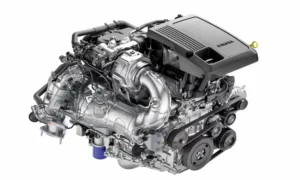If you’ve seen the P249D code on your Duramax, you’re likely dealing with issues in your truck’s emissions system. This problem often involves the diesel exhaust fluid (DEF) injection or the reductant system in your engine. Knowing what triggers this code and how to fix it can save you from bigger headaches down the road. Dive into this guide to find out how you can address your Duramax issues effectively.
Symptoms of the P249D Error
When the P249D error code appears on your Duramax, you might notice various symptoms related to both visibility on the dashboard and the performance of your engine. Recognizing these symptoms early can help you address the issue promptly.
Visible Symptoms
One of the first things you might see is the Engine Light or the Service Engine Soon Warning Light on your dashboard. These lights act as an early alert system to problems in your engine.
You might also notice error messages related to the Diesel Exhaust Fluid (DEF) system. These indications are usually displayed in the driver information center and should not be ignored.
The illumination of these warning lights can sometimes come with additional indicators related to low DEF levels or issues with the DEF injector. It’s crucial to pay attention to these signs and investigate further if they appear.
Performance-related Symptoms
Performance-related issues that come with the P249D error can affect how your Duramax engine operates. You might notice a reduction in engine power, often referred to as “limp mode.” This is a safety feature to prevent further damage.
When the engine is idling, it might run rough or have an uneven idle. Poor exhaust gas recirculation can cause these idle issues.
Another key symptom is decreased fuel efficiency. Problems with the DEF system can lead to improper combustion and reduced engine performance, affecting your truck’s overall fuel economy.
These performance issues can make your vehicle less reliable and less efficient, so it’s important to address them as soon as possible.
Recognizing these symptoms will help you identify the P249D error and take necessary actions for your Duramax engine.
Causes Behind the P249D Code
The P249D code on a Duramax engine can be caused by several issues related to the fuel system, sensors, catalysts, and wiring connectors. Understanding these root causes will help you diagnose and fix the problem effectively.
Fuel System Issues
One of the primary reasons for the P249D code is fuel system issues. Contaminated fuel can disrupt engine performance. If the fuel is polluted with dirt, water, or other contaminants, it affects the DEF (Diesel Exhaust Fluid) injection rate. This is crucial for proper engine functionality.
Low-quality fuel can lead to improper combustion and higher emissions. This puts extra pressure on your Selective Catalyst Reduction (SCR) Catalyst. Regularly check for fuel contaminants and replace filters as necessary.
Sensor and Catalyst Failures
The P249D code can also be triggered by faulty sensors. A failing NOx sensor may give incorrect readings, affecting engine performance. The SCR catalyst can also fail, giving a P249D code.
A malfunctioning Diesel Particulate Filter (DPF) affects the overall emissions system. If sensors are giving inaccurate data, the engine control unit (ECU) can’t manage emission levels properly.
Wiring and Connector Problems
Wiring harness and connectors play a big role in the P249D code. Damaged wiring or corroded connectors can cause communication errors. Such problems lead to insufficient DEF injection, affecting your emissions.
Visually inspect the wiring for any wear and tear. Make sure all connectors are corrosion-free and properly attached. Damaged components need immediate replacement to avoid ongoing issues.
Potential Repairs for the P249D Code
Fixing the P249D code often involves checking and repairing specific components like the reductant injector and wiring harness. These repairs can vary in complexity, making it important to understand both basic and advanced steps.
Basic Troubleshooting Steps
Start by visually inspecting the wiring harness and connectors. Look for any signs of damage such as broken, bent, or corroded pins. If you notice anything unusual, repair or replace the affected parts.
Next, use an OBD-II scanner to clear the code and see if it reappears. This can sometimes fix the issue if it was a temporary glitch.
Additionally, check the DEF injector. You may need to clean it if it’s clogged. This is a relatively simple task that doesn’t require specialized tools. Cleaning or replacing the DEF injector can often solve the problem quickly.
Finally, ensure that the DEF tank is filled. Low levels can trigger the P249D code. Topping off the tank may resolve the issue without further repairs.
Advanced Repairs and Part Replacements
If basic troubleshooting doesn’t solve the problem, you might need to replace more complex parts. For example, replacing the reductant injector often fixes this code. You can find the part, such as the DEF injector available from various suppliers, and replace it following manufacturer’s guidelines.
Another potential repair involves the Diesel Particulate Filter (DPF). If the DPF is clogged, it can cause low flow in the reductant injection system. In this case, cleaning or replacing the DPF might be necessary.
NOx sensors are also critical. Faulty sensors can lead to incorrect readings and trigger the P249D code. Replacing these sensors can be more challenging and might require professional assistance.
The Selective Catalytic Reduction System could also be at fault. In-depth diagnostics will identify whether components of this system need repair or replacement. This is generally a more advanced and time-consuming repair, often best left to professionals.
Understanding Reductant and Emission Systems
Emission systems in diesel engines use various components like Diesel Exhaust Fluid (DEF), NOx sensors, and filters to reduce pollutants. Each part plays a crucial role in maintaining the engine’s performance and meeting emission standards.
Diesel Exhaust Fluid (DEF) and Its Function
Diesel Exhaust Fluid (DEF) is a key element in reducing the harmful emissions from your engine. DEF is injected into the exhaust stream, where it breaks down harmful nitrogen oxides (NOx) into nitrogen and water vapor. This fluid is stored in a separate tank and needs regular refilling.
DEF consists of 32.5% urea and 67.5% deionized water. It’s essential to use the proper DEF for your engine’s selective catalytic reduction (SCR) system to function correctly. One common issue with DEF is low flow, indicated by the P249D code, which can mean the system is not injecting enough reductant.
NOx Sensors and Their Role
NOx sensors monitor the levels of nitrogen oxides in the exhaust stream. These sensors are placed both before and after the SCR catalyst. They help your vehicle’s Engine Control Module (ECM) to regulate the amount of DEF injected.
The sensors provide real-time data that helps in reducing tailpipe-out NOx levels. If these sensors malfunction, incorrect readings can lead to improper DEF injection and increased emissions. Regular check-ups can help in identifying any issues early on.
Diesel Particulate Filter and SCR Catalyst
The Diesel Particulate Filter (DPF) and the Selective Catalytic Reduction (SCR) catalyst work together to reduce emissions. The DPF captures soot and particulate matter from the exhaust, while the SCR catalyst uses DEF to convert NOx into harmless substances.
Maintaining these components is crucial. A malfunction can lead to codes like P249D, which indicates issues like a flow too low in reductant injection. Cleaning and replacing these filters and catalysts as needed will help. Regular maintenance ensures that your emission levels stay within legal limits and your engine runs efficiently.
Preventing Future P249D Errors
To avoid future P249D codes, focus on consistent maintenance and early detection. Regularly checking engine components can prevent issues such as exhaust leaks or fuel contamination.
Regular Maintenance Tips
Regular maintenance can help prevent the P249D code. Schedule routine inspections for the engine’s reductant system, including DEF injectors and related wiring harnesses. Make sure to replace worn parts promptly.
Look for signs of damage or wear in the upstream and downstream NOx sensors, which play a key role in the exhaust system. Any issues here can lead to engine light warnings.
Keep an eye out for exhaust leaks. These can affect the engine’s performance and lead to error codes. Listening for unusual noises and checking for visible leaks can save you trouble. Ensuring the diesel exhaust fluid (DEF) tank is always filled with high-quality DEF will help to avoid contamination problems.
Early Detection and Diagnosis
Detecting problems early is crucial for avoiding more serious issues. Pay attention to the engine light. If it comes on, use an OBD-II scanner to identify the specific code. Catching something early can often mean a simple fix rather than a complicated repair.
Regularly inspect the upstream and downstream NOx sensors for proper function. A quick scan can reveal if anything is out of alignment.
Additionally, checking for fuel contamination should be part of your routine. Contaminated fuel can lead to system failures, affecting the reductant system. Make sure to use clean fuel, and if you suspect contamination, get it checked immediately.
By sticking to these practices, you can catch issues early and avoid long-term problems.















